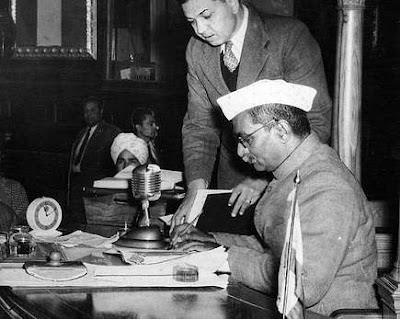✔ Who suggested Indian Constitution :
It was in 1934 that the idea of a Constituent Assembly for India was put forward for the first time by M. N. Roy.
✔ The Constitution Was Originally Written in Hindi and English :
The original copies of our constitution were drafted in two languages – Hindi and English. Both these copies were signed by each member of the constituent assembly.
✔ First Meeting :
The first meeting was held on 9 December 1946 in the constitution hall (now the Central Hall of Parliament House). The 1st person to address was J. B. Kripalani, Sachchidananda Sinha became temporary president.
✔ Rajendra Prasad was appointed as its President :
The Assembly appointed Rajendra Prasad as its president, H. C. Mukherjee as its vice-chairman and B. N. Rau as constitutional legal adviser. (There were initially 389 members in total, which declined to 299 after partition. Out of the 389 members, 292 were from government provinces, four from chief commissioner provinces and 93 from princely states.)
✔ Longest and Largest Constitution in the World :
Besides being known as largest constitution in the world; 117,369 words make it the longest constitution in the world. Another fun fact: The constitution of Monaco is the shortest with 3,814 words. It has a Preamble, 22 parts with 448 Articles, 12 Schedules, 5 Appendices and 115 Amendments.
✔ It Was Handwritten by Prem Behari Narain Raizada :
The Indian constitution was published in Dehradun by Prem Behari Narain Raizada, an Indian calligrapher who hand-wrote the entire constitution. It was written in a flowing italic style.
✔ Each Page Was Decorated by Artists from Shantiniketan :
The original hand-written constitution was decorated by artists from Shantiniketan – a neighbourhood that was expanded by Rabindranath Tagore.
✔ It took almost 3 years to write it down :
The Constituent Assembly took almost three years ( 2 years, 11 months and 17 days to be precise) to frame the Indian Constitution.
✔ The Original Copies Are Stored in Special Cases :
The original copies of the Indian Constitution, which were written in Hindi and English, are kept in special helium-filled cases in the Library of the Parliament of India. They are 22 inches long and 16 inches wide.
✔ 24 January 1950: Last meeting of Constituent Assembly :
The Constitution was signed and accepted (with 395 Articles, 8 Schedules, and 22 Parts). A total of 283 members of the constituent meeting had signed the original Constitution of India.
✔ Who signed first indian constitution :
Dr. Rajendra Prasad, The First President of India became the first person to sign the constitution of India.
✔ 26 January 1950 - The Constitution Was Legally Enforced :
That’s the date when our Constitution was legally enforced. Another fact: The date 26 January was chosen to declare Purna Swaraj or complete independence back in 1930.
✔ Over 2000 amendments were made to the first draft of the Constitution.
✔ Total expenditure of ₹6.4 Million to finish.
✔ 26 January 1950: The National Emblem of India Was Adopted :
Our National emblem – The ‘Lion Capital Of Ashoka’ was adopted on 26 January 1950. It has 4 Asiatic Lions standing back to back that symbolize power, courage, pride and confidence.
✔ The Father of The Indian Constitution, Dr Ambedkar, Was Ready to Burn It :
BR Ambedkar is recognised as the Father of the Constitution of India. Only three years after our Constitution was adopted, its chief architect, BR Ambedkar, publicly disowned it in Parliament. In an astonishing admission in 1953, he condemned it in the Rajya Sabha:
“Sir, my friends tell me that I have made the Constitution. But I am quite prepared to say that I shall be the first person to burn it out. I do not want it. It does not suit anybody.”
Ambedkar made this statement as a reaction to some of the issues of the constitution never being addressed, one of which was the fact that the Governor of states has no real power and is for all realistic purposes, just a ‘rubber-stamp head’. Ambedkar was also critical of the parliamentary form of Democracy and believed that it did not fit with the complex social structure of India.







No comments:
Post a Comment